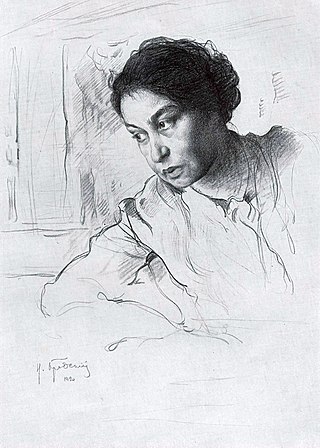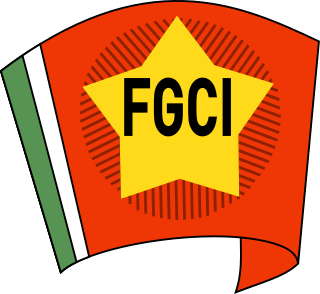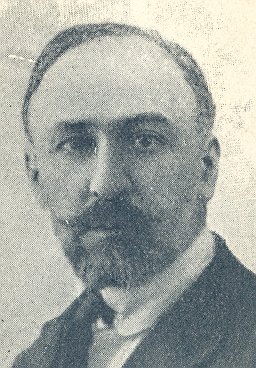
The I Congress of the Communist Party of Italy was held in Livorno on 21 January 1921, following the split of the communist fraction at the end of the XVII Congress of the Italian Socialist Party (PSI). [1] [2]

| Part of a series on |
| Communism in Italy |
|---|
 |
The I Congress of the Communist Party of Italy was held in Livorno on 21 January 1921, following the split of the communist fraction at the end of the XVII Congress of the Italian Socialist Party (PSI). [1] [2]
The Italian Socialist Party (PSI) joined the Communist International in 1919. [3] : 28 Although the party had adopted left-wing positions against the First World War it nevertheless contained a broad range of political opinions. While the majority of the party was pro-Bolshevik by 1919, a strong reformist right wing remained within the party, led by one if its founders, the leader of the parliamentary group Filippo Turati. [4] Giacinto Menotti Serrati, leader of the majority grouping in the PSI, had led the party into the Comintern but was nevertheless opposed to expelling right wing figures, fearing this would alienate a large section of the party’s supporters. [5]
The uneasy internal arrangements of the party were upset by the II Congress of the Comintern in July and August 1920, which laid down 21 conditions for all parties to remain within the International; one of the conditions was that all reformists - such as Turati - were to be expelled. [1] [6] In September 1920, the left wing of the PSI secured approval for an agenda for its forthcoming XVII Congress signed by which proposed the complete and unconditional adoption of the Comintern’s 21 points. [3] : 84
Within the PSI the two main leaders of the communist fraction were Amadeo Bordiga and Antonio Gramsci. [3] : 84–81 [6] : 15 They mobilised their supporters in the months before the Congress to follow the Comintern line and expel the right-wingers. The fraction agreed a manifesto-programme signed in Milan on 15 October 1920 by Bordiga, Gramsci, Misiano, Terracini, Bombacci, Repossi, Fortichiari and Polano. [7] A few days later the fraction gained the approval of Zinoviev who, also on behalf of Lenin, Trotsky and Bukharin, underlining how it constituted the only support of the International in Italy. [3] : 91–92
The motion that the communists intended to present to the Congress was ratified in a conference held at the Municipal Theater of Imola between 28 and 29 November, and for this reason it was also called the Imola motion. [6] : 15 The text aimed at the transformation of the Socialist Party into a Communist Party, making it necessary to exclude all those who voted in the Congress "against the Communist program of the Party and against the commitment to complete observance of the 21 conditions of admission to the International». The Imola conference did not explicitly deal with the path to follow in the event that the motion remained in the minority at the congress, but the hypothesis of the split was already concretely outlined. [3] : 105
The debate at the Socialist Party Congress took place in a particularly turbulent climate and interruptions and tumults were frequent. [3] : 109 The International delegates, Khristo Kabakchiev and Mátyás Rákosi, supported the motion from the Communist fraction, harshly attacking Serrati. [8] : 64–67 Their support was not however sufficient to prevent the majority of Congress delegates from supporting an alternative motion from Serrati, emphasising the importance of maintaining party unity and rejecting expulsions. [3] : 112–113 [8] : 56 On the morning of 21 January 1921, the declaration of the results of the voting made clear that the Communist fraction’s motion had not succeeded, while Serrati’s opposition to expulsions commanded the support of the party. Bordiga therefore proceeded to formalize a split of the Communist fraction from the rest of the party. [3] : 115 [8] : 71–72

The delegates of the communist fraction walked out if the PSI Congress singing of the Internationale [8] : 71–72 and, following Bordiga, proceeded to hold the founding Congress of the Communist Party at the it:Teatro San Marco. It was a makeshift arrangement: the building, used as a warehouse for materials of the Royal Italian Army during the First World War, had no seats, and the delegates sheltered with umbrellas from the rain that entered through the broken glass of the windows and from the holes in the roof. [9]

The Congress was held over two sessions during the single day of Friday 21 January, and limited itself to giving the new party an initial organizational framework. The morning session hosted the greetings of the foreign delegates Kabakchiev, Rosa Bloch, Jules Humbert-Droz, Balfour, de:Paul Böttcher and Arvid G. Hansen and the interventions of Bruno Fortichiari on behalf of the Central Committee of the fraction; by Luigi Polano for the young people; by Ortensia De Meo for the women and four workers and trade unionists. In the second session, an agenda signed by Fortichiari was voted on which declared the Communist Party of Italy (PCd’I) - Section of the Communist International established. This name would remain in force until the dissolution of the International in 1943, when the party re-emerged under the name of the Italian Communist Party after being forced underground in 1926 by the Fascist regime.
The congress chose Milan as the headquarters of the party and, as its official organ, the biweekly Communist. Finally the Central Committee was elected, consisting of Bordiga, Grieco, Parodi, Sessa, Tarsia, Polano, Gramsci, Terracini, Belloni, Bombacci, Gennari, Misiano, Marabini, Repossi and Fortichiari. [10] The role of general secretary was not established, although it was in fact fulfilled by Bordiga.
The establishment of the PCd'I was completed a few days later, on 27 January, with the Florence Congress of the Socialist Youth Federation, which decided by a very large majority to withdraw its membership of the Socialist Party to join the new Communist Party, under the new name of the Italian Communist Youth Federation.

Antonio Francesco Gramsci was an Italian Marxist philosopher, linguist, journalist, writer, and politician. He wrote on philosophy, political theory, sociology, history, and linguistics. He was a founding member and one-time leader of the Italian Communist Party. A vocal critic of Benito Mussolini and fascism, he was imprisoned in 1926, where he remained until his death in 1937.

Amadeo Bordiga was an Italian Marxist theorist. A revolutionary socialist, Bordiga was the founder of the Communist Party of Italy (PCdI), member of the Communist International (Comintern), and later a leading figure of the Internationalist Communist Party (PCInt). He was originally associated with the PCdI but was expelled in 1930 after being accused of Trotskyism. Bordiga is viewed as one of the most notable representatives of left communism in Europe.

The Italian Communist Party was a communist and democratic socialist political party in Italy. It was founded in Livorno as the Communist Party of Italy on 21 January 1921, when it seceded from the Italian Socialist Party (PSI), under the leadership of Amadeo Bordiga, Antonio Gramsci, and Nicola Bombacci. Outlawed during the Italian fascist regime, the party continued to operate underground and played a major role in the Italian resistance movement. The party's peaceful and national road to socialism, or the Italian road to socialism, the realisation of the communist project through democracy, repudiating the use of violence and applying the Constitution of Italy in all its parts, a strategy inaugurated under Palmiro Togliatti but that some date back to Gramsci, would become the leitmotif of the party's history.

Luigi Longo, also known as Gallo, was an Italian communist politician and general secretary of the Italian Communist Party from 1964 to 1972. He was also the first foreigner to be awarded an Order of Lenin.

International Communist Party can refer to a handful of different left communist political parties with the same name, all of which split from the original ICP lead by Amadeo Bordiga in 1952, itself a split from the Internationalist Communist Party. The name of each ICP is generally distinguished from the others by using the name of its party press, such as "International Communist Party (Partito)" to refer to the ICP which publishes the newspaper Il Partito Comunista.

Angelica Balabanoff was a Russian-Italian communist and social democratic activist of Jewish origin. She served as secretary of the Comintern from 1919 to 1920, and later became a political party leader in Italy.

Bruno Fortichiari was an Italian politician and communist revolutionary. He was among the founders of the Communist Party of Italy (PCd'I) in 1921.

Onorato Damen, was an Italian left communist revolutionary who was first active in the Italian Socialist Party and then the Communist Party of Italy. After being expelled, he worked with the organized Italian left, became one of the leaders of the Internationalist Communist Party, commonly known by their paper Battaglia Comunista.

Camilla Ravera was an Italian politician and the first female lifetime senator. She was also among the driving forces behind Italian feminism.

The Italian Communist Youth Federation was the youth wing of the Italian Communist Party, and the direct heir of the Federazione Giovanile Comunista d'Italia of the PCd'I.

Count Antonio Graziadei, also known as Tonio, was an Italian academic and politician. One of the co-founders of the Italian Communist Party, he was Professor of Political Economy at the Universities of Cagliari and Parma and a member of the Italian Parliament from 1910 to 1926. In 1928 he went on a self-imposed exile to France to escape fascism. After the war he began his teaching activity at the University of Rome.
The Communist Party of Fiume was instituted in November 1921, after the proclamation of the Free State of Fiume created by the Treaty of Rapallo. The Communist Party of Fiume was the smallest Communist Party in the world at the time. It was founded following the principles of the Third International, according to which each sovereign State had to have its own Communist Party organization.

Ruggero Grieco was an Italian politician, antifascist, and member of the Italian Communist Party. He was born in Foggia, Apulia.

The Communist Party of Italy was a short-lived communist party in Italy which represented a transition period between the Party of Italian Communists (1998–2014) and the Italian Communist Party (2016–present).

Fausto Gullo was an Italian politician.

The Maximalist Italian Socialist Party or PSIm, was the residual part of the Italian Socialist Party in exile following the split that occurred during the first phases of the Socialist Convention of Grenoble, held on 16 March 1930, by Pietro Nenni and the fusionist fraction.

Mauro Scoccimarro was an Italian economist and communist politician. He was one of the founders of the Italian Communist Party and served as the minister of finance between 1945 and 1947.

Egidio Gennari was an Italian communist politician who was among the founders of Italian Communist Party. He served at the Italian Parliament between 1924 and 1926 when he was forced to leave Italy due to the repression of the Fascist government. He died in exile in the Soviet Union.
Paolo Spriano was an Italian historian of the Italian labor and communist movement.

The XVII Congress of the Italian Socialist Party (PSI) was held at the Carlo Goldoni Theatre in Livorno from 15 to 21 January 1921. After tumultuous proceedings the congress resulted in a split in the party. The communist faction, faced with the refusal of the majority to accept the Comintern line and expel reformists and gradualists, abandoned the PSI and established a new Italian Communist Party.